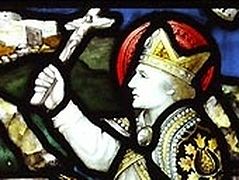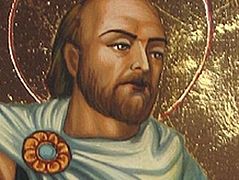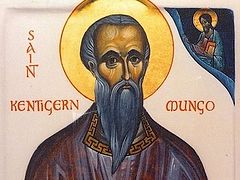 A sculpture of St. Neot
A sculpture of St. Neot St. Neot lived in the ninth century. He was of noble birth. It is believed by many researchers that the saint was related to the royal family of either Wessex or East Anglia. Neot began life as a soldier but after some time he resolved to give up a military career and dedicate his life to the service of God and prayer. Thus he entered the famous monastery in Glastonbury in Somerset in the Kingdom of Wessex and served there as a sacristan. It is not known where and by whom he was ordained a priest. After some time at Glastonbury, where he obtained a good education, Neot felt a calling to live a more ascetic life in solitude. So he retired to Cornwall where he spent the rest of his life as a hermit in a tiny cell.
 One of ancient crosses in St Neot churchyard, Cornwall
One of ancient crosses in St Neot churchyard, Cornwall After many years of unceasing prayer and contemplation, St. Neot gathered disciples around him and founded a small monastery next to his hermitage, becoming its abbot. Little is known about the life of that monastery, but it still existed in the eleventh century. The Life of St. Neot relates that the saint was so short that he had to get up on a chair each time to serve the Divine Liturgy. Bishop Asser in his Life of Alfred the Great tells us that during the Danish raids on England, the King visited the cell of St. Neot. The latter blessed him to fight in the decisive battle with the Danes and predicted his victory. Obviously Neot was a confessor of the King. It is also known that St. Neot, along with St. Cuthbert of Lindisfarne, appeared to King Alfred in a vision shortly before his final victory over the pagans.
According to tradition, once thieves stole the saint’s oxen (it was after the foundation of the monastery by the saint), and a generous ploughman who lived nearby took pity on the man of God and gave him his deer, which from that time helped Neot plough the fields. After a while the same thieves who had stolen Neot’s oxen repented: they came to the saint, asked for forgiveness, returned him the oxen, received the saint’s blessing and themselves became devout monks. It was said that every day Neot prayed hard in the well not far from his hut: he used to immerse himself in its water to his neck and recite the whole Psalter—a practice which can be met in the lives of a host of Celtic and early English saints.
 Holy well of St. Neot in St Neot village, Cornwall
Holy well of St. Neot in St Neot village, Cornwall Everybody loved Neot for his holy life, wisdom and care for the sick and the needy. Since time immemorial he has also been venerated as the patron of fish. This veneration is based on the following story from his life. There was a holy stream at a short distance from the saint’s hermitage cell. Three fish lived in that stream. An angel that appeared to the saint told him that if he would eat no more than one fish a day from this stream, then there would always all the same remain three fish. So it was for many years—the number of fish in the spring did not decrease. Once Neot fell ill. One monk then decided to take care of him. He caught two fish from the stream, broiled them and offered them to the saint. Neot, seeing that the angel’s command had been violated, prayed fervently: and, behold, by a miracle both fish instantly returned to life so the saint released them back into the stream.
Some images of St. Neot depict him protecting a doe. This is connected with the following story: once as the saint was praying, he saw a doe that had been running for a long time from hunters with fierce hounds, seeking his protection. As soon as the hounds appeared, the saint looked towards them—at the very sight of the righteous man of God the dogs immediately turned back and obediently ran away. One of the hunters was so impressed that he soon became a monk in the saint’s community. St. Neot had such close relations with nature that mammals, fish and birds served him as their master. According to a legend, residents of many neighboring villages loved to come to St. Neot’s church for the services and listen to the saint’s sermons.
Once a great multitude of crows began to eat the crops and everything they could from the fields, damaging them greatly. People watched over their fields every day of the week apart from Sundays when they went to church, so the crows only ate on Sundays. Thus people ceased to go to church on Sundays, preferring to guard their crops. The saint of God understood the reason and decided to act. He built a large compound of earth and granite (in fact it is a Roman or early British earthwork) and ordered the crows to gather in it every Sunday at the time of Liturgy: because people should hear the Word of God and because it was bad to harm the fields. The birds obeyed immediately and as long as the saint was alive they flew to the compound every Sunday and remained there till the end of the Liturgy.
St. Neot reposed in the Lord as a very old man close to the end of the ninth century (probably about the year 877). After his death many miracles occurred near his relics. These were enshrined in the church dedicated to him in the settlement of St. Neot in Cornwall (the site of his spiritual labors).
In 972-974 Earl Leofric with his wife Ethelfleda established a monastery in the town of Eynesbury in the county of Huntingdonshire (now part of Cambridgeshire) and settled a community of monks from Thorney (also in Cambridgeshire) there. The saintly Bishop Oswald of Worcester, who restored the monastery in Thorney as well as many other monasteries nationally, may have assisted in founding this monastery. At the same time most of St. Neot’s relics were translated to the newly established Eynesbury Monastery where they were venerated for many years, attracting numerous pilgrims, while part of the saint’s relics remained in St. Neot in Cornwall.
In about 1085, Eynesbury Monastery was re-founded by the Norman Archbishop of Canterbury Anselm as a Benedictine priory, and it became dependent on Bec Abbey in Normandy. He also translated a minor relic of St. Neot to Bec; thus veneration of the hermit spread to France. In the twelfth century, monks of Eynesbury acquired a separate estate with lands near Eynesbury, so a new settlement, later a whole town, grew around this community. This town with time came to be called St. Neots in honor of St. Neot, its most venerated saint. This market town exists in Cambridgeshire to this day and Eynesbury is one of its districts. St Neots stands on the Great Ouse River, and since ancient times it has been known as “the jewel of the Ouse”. So, two settlements in present-day England still bear the name of our saint: St. Neot in Cornwall and St. Neots in Cambridgeshire.
 Mosaic in honor of St. Neot in the square of the town St Neots, Cambridgeshire
Mosaic in honor of St. Neot in the square of the town St Neots, Cambridgeshire St. Neot was venerated in St. Neots till the Reformation. In the fifteenth century the brethren of St. Neots finally obtained independence, though the community remained relatively small until the dissolution of the monasteries in about 1540. The antiquary and traveler John Leland, who visited St. Neots in the early sixteenth century, wrote that he saw in a local church “the tunic of St. Neot as well as his personal comb, which was a small bone, two fingers wide, into which tiny fish bones were inserted so that the comb resembled a pike’s jaw”.
Nowadays the Cornish village of St. Neot is famous for its medieval church dedicated to St. Neot. This magnificent church boasts numerous splendid stained glass windows (some of them are ancient). Two windows depict the scenes from the life of St. Neot (both most likely date back to the sixteenth century). There is a tomb recess in the north wall of the chancel which could be a part of the shrine of St. Neot. At least five ancient crosses, one of which may be associated with Alfred the Great (dates back to the ninth century!), can be found near the church door and in the churchyard. St Neot’s well is situated close to the church. The saint is venerated by the local community and its guests.
The town St. Neots in Cambridgeshire is unique as it (together with its close suburbs) has three churches dedicated to the Mother of God. The one which stands in the heart of the town closer to the river is linked with St. Neot. Although almost no traces of the former Priory of St. Neot survive in the town, this church of St. Mary the Virgin stands approximately on the site of the monastery. The church is mainly of the fifteenth century, but some parts are earlier and may date to the late twelfth century. A portion of St. Neot’s relics is believed by some to lie inside this fine church (though concealed) to this day. A commemorative mosaic dedicated to St. Neot can be seen in the town’s Market Square. St. Neot is also venerated in Glastonbury and Malvern in western England.
Holy Father Neot, pray to God for us!







